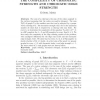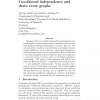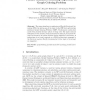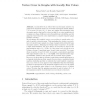1749 search results - page 41 / 350 » Conditional colorings of graphs |
ESA
2006
Springer
14 years 5 days ago
2006
Springer
A coloring is proper if each color class induces connected components of order one (where the order of a graph is its number of vertices). Here we study relaxations of proper two-c...
CC
2006
Springer
13 years 8 months ago
2006
Springer
The sum of a coloring is the sum of the colors assigned to the vertices (assuming that the colors are positive integers). The sum (G) of graph G is the smallest sum that can be ach...
AI
2008
Springer
13 years 8 months ago
2008
Springer
Graphs provide an excellent framework for interrogating symmetric models of measurement random variables and discovering their implied conditional independence structure. However,...
PPAM
2007
Springer
14 years 2 months ago
2007
Springer
Abstract. The paper describes an application of Parallel Simulated Annealing (PSA) for solving one of the most studied NP-hard optimization problems: Graph Coloring Problem (GCP). ...
ICALP
2011
Springer
12 years 12 months ago
2011
Springer
In [13], Erd˝os et al. defined the local chromatic number of a graph as the minimum number of colors that must appear within distance 1 of a vertex. For any ∆ ≥ 2, there are ...




